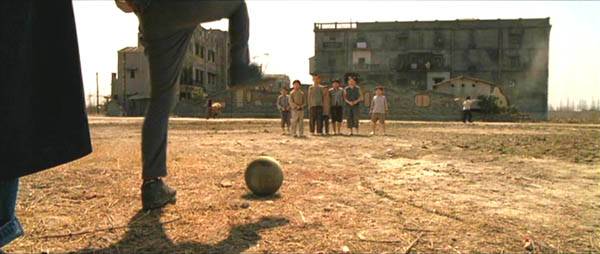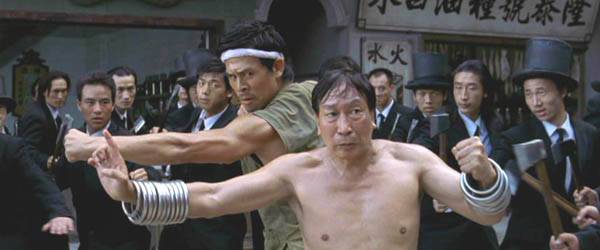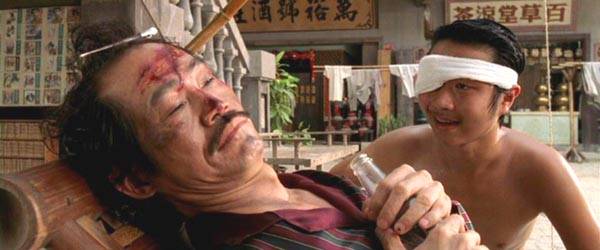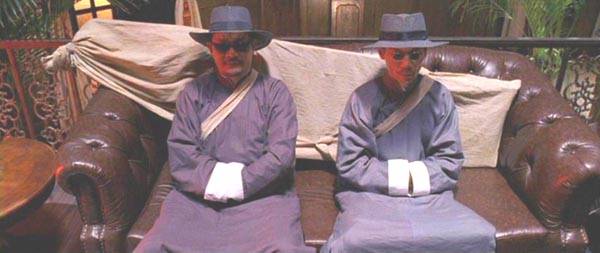“No more soccer” introduces Stephen Chow, who plays the protagonist Sing, stepping on a kid's ball, as he bids farewell to his earlier hit Shaolin Soccer (2001). The film layers reference upon reference from there, drawing on the history of the Hollywood and Hong Kong cinema rather than the history of Southern China for its visual and narrative context. For example, Sing and the mute girl, who sticks by her childhood friend even when he pulls a knife on her, pose under a poster of Fred Astaire and Ginger Rogers in the same position dancing in Top Hat (1935). Feng Xiao Gang, the popular comedy director of Be There Or Be Square (1998), Big Shots Funeral (2001), Cell Phone (2003), and A World Without Thieves (2004, starring Hong Kong's Andy Lau), Stephen Chow's mainland counterpart/competitor, plays the head of the Crocodile gang. Casting Feng as the Mandarin speaking gang leader in an underworld filled with Cantonese triads provides a witty commentary on PRC popular film intruding into a cinema world dominated by Hong Kong comedy, action, and melodrama.

The Northern/Southern competition off-screen continues in the narrative. All sides jockey for power and try to appeal to the “guan xi” of the “jiang hu” for their own advantage. The Northern “Crocodile” triad reminds the enforcer who kills him of the time he paid for his assassin's dinner. Stephen Chow/Sing appeals to the landlady that they are “on the same side” against the victimized tenants to try to get her to back off, and he then goes against her when the real Axe Gang appears by greeting them as “brothers.”
Until Sing who tries to hustle the residents of Pig Sty Alley appears, this corner of Shanghai had been off the triad map and a haven for martial artists in hiding. Most of these characters are portrayed by respected martial artists, kung fu film actors, and Peking Opera performers. As the plot unfolds, the martial artists come out of “hiding,” and the retired actors and underutilized kung fu performers shine on screen. The landlady/Helen of Troy, a master of the “lion's roar,” is played by Cheung Cheun Nam (a.k.a. Yuen Qiu), who studied Peking Opera with Jackie Chan, Yuen Biao, and Sammo Hung as a child. Yuen Wah, who also trained with Jackie Chan and the others in Peking Opera, plays her husband/Paris, a tai ji master. The tenement's effeminate tailor is broadly played by Chu Chi Ling, who is an actual Hung Gar master with a school in San Francisco . He appeared in films like Snake In The Eagle's Shadow (1978), which Yuen Woo Ping directed. Dong Zhi Hua, who plays the cook, trained in the mainland and worked with Chang Cheh on a number of films. Xing Yu, the coolie, trained in Shaolin kung fu, runs a branch of the temple in Shenzhen.

Kung Fu Hustle provides an inventory of its masters' talents—so that their skills can be authenticated. The coolie/ Xing Yu displays moves based on the Twelve Kicks from the Tam School . An important component of Northern Shaolin, Tam/Tan Tui—springy leg—highlights complicated footwork and expansive kicks. According to the popular understanding of the differences between Northern and Southern Shaolin kung fu, the Northern styles rely on long range techniques developed for fighting in the open plains of Northern China, while the Southern systems feature lower kicks, shorter range techniques, and more complex strikes and blocks suitable for fighting in marshy or hilly areas in the South. When martial arts became a competitive sport known simply as “wu shu” (“martial arts”) in the PRC, the springy leg Tan Tui form became one of the more popular sets for competitions.
The tailor/ Chiu Chi Ling uses rings, which conveniently also hold up the curtains in his shop, associated with Southern Shaolin training for arm strength and protection. He is acknowledged as a master of Hung Gar's Iron Wire Fist created by Leung Kwan/Tit Kiu Sam, one of the Ten Tigers of Guangdong. The Iron Wire Fist form emphasizes the “internal”—breathing, marshalling of “qi” (“hei” in Cantonese), and redirecting this energy. The tailor does some breathing exercises to warm up before engaging his opponent—the stances, hand movements, and breath control are all consistent with the form. Although the iron rings worn for training do not have much combat significance (leather braces with metal studs are more often worn for forearm protection and to aid offensive strikes), they do look good and indicate a typical visual Hung Ga feature for the audience.

The cook/ Dong Zhi Hua uses the Ba Gua Staff, so intimately connected with Wong Fei-Hung, Hung Gar, and its popularization by Kwan Tak Hing. Like The Story Of Wong Fei-hung : Part I, Kung Fu Hustle brings together Northern Shaolin, Hung Gar, and Peking Opera to create his cinematic vision of the “jiang hu.” The three masters spar in order to better appreciate each other's skills. The tailor uses a fan (also a traditional weapon) with Hung Gar hand techniques. For the cook, a short pole substitutes for the Ba Gua staff. The sparring session ends with a traditional bow, sunset behind, and the film's commitment to comedy over martial artistry resurfaces when the tailor falls off the balustrade on which he perched.
Once they reveal themselves as masters, however, they become targets. The Axe gang hires two blind zheng (zither) players to do away with them. Like the blind performer in The Story Of Wong Fei-hung : Part I and the sisters in Wong Fei Hong: The Invincible Lion Dancer, these blind street musicians form such a common part of the pre-1949 Chinese cityscape that they can become “invisible” assassins. Played by Jia Kang Xi and Fung Hak On , with considerable experience in Peking Opera and Shaw Brothers films, the assassins recognize each master's talent and devise a strategy to use the mystical powers of their zither to combat them. In an alleyway reminiscent of the enclosed spaces in which Wong Fei-Hung/Kwan Tak-Hing so often met his opponents, one assassin decapitates the coolie without a fight. His comrade uses Hung Ga style “tiger claw” (accentuated by his long fingernails) to attack the tailor who flips the steel rings onto his forearms to begin his counterattack. However, the zither player begins to fling ghostly broadswords at him in the courtyard. The cook appears with a spear to ward off the two musicians, and he continues with Peking style opera techniques using two spears to deflect the assassin's spectral daggers.

Eventually, the landlady's “roar” gives her away as an additional “master.” Her yell sends the musicians' ghostly warriors flying—disintegrating into skeletons. The “lion's roar,” fanciful in the film, has its roots in Tibetan martial arts. The landlord also reveals himself to be a kung fu master, and he effortlessly uses tai ji evasive techniques to redirect the assassins' aggression back on themselves. Twisting to hurl them away, the landlord inscribes a yin/yang symbol on the tenement courtyard's pavement and stops in a tai ji pose. In martial arts tradition, “internal” arts like tai ji are considered superior to the “external” arts. While most kung fu systems have “internal” as well as “external” techniques, most are associated with one or the other, particularly at the beginning stages of training. With the “lion's roar” and tai ji , Kung Fu Hustle ventures into the “internal” arts, exaggerating the power of qi through computer imaging. |
